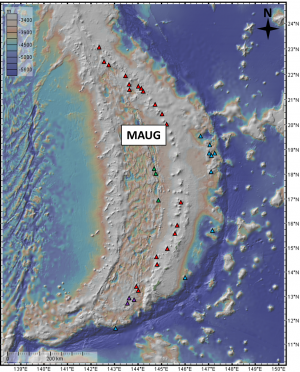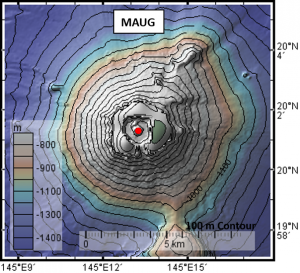
Maug Vent


Latitude: 20.021οN Longitude: 145.222οE Depth: 54 m bsl
Maug is an extinct volcano located in the Central Seamount Province (Bloomer et al., 1989). Maug consists of three islands arranged in a circular pattern around a caldera in which sits a resurgent dome that almost reaches sealevel (Submarine Ring of Fire, 2003). ROV dives found several diffuse vents clustered on the ENE quadrant of the central cone (Embley et al., 2007). Fluids released from weak vents around the central dome show elevated 3He levels and suggest that the central dome is actively degassing. These fluids are also enriched in CO2, TDMn, TDFe, pFe, and pMn (Resing et al., 2009). Maug is one of the few places on earth where photosynthetic and chemosynthetic life coexist. This unique community is composed of Bacteria, Fish, Soft corals, Gorgonians, Brittle stars, Worms and Mussels (Pala, 2009).
Table 1: Operations history for Maug vent
| Ship/ Platform | Operation | Year |
Dive Number |
References |
|
TN-153 R/V T. G. Thompson |
EM 300 multibeam |
2003 February – March |
Not found |
Submarine Ring of Fire 2003 |
|
TN-167 R/V T. G. Thompson |
CTD Verical cast; ROPOS |
2004 March- April |
R789, R790 |
| Activity and host rocks | References | |
| Activity | Active | Baker et al., 2008 |
| Host Rocks |
Dacite Basalt |
Embley et al., 2007 Woodhead., 1989 |
Table 3: Vent fluid characteristics
|
Vent Fluids |
References | |
|
Temperature (οC) |
60 οC (at 30 feet deep)
Low T (<100 οC) |
Pala., 2009
Embley et al., 2007 |
| pH | 6.07 | Pala., 2009 |
| ΔpH | -0.17 | Resing et al., 2009 |
| Composition |
Large concentrations of methane, total (particulate plus dissolved) Fe, and total Mn. CO2 and alkalinity |
Resing et al., 2009 |
| CO2 (mM) | Not found | |
| ΔCO2 (mM) | 119 | Resing et al., 2009 |
| H2 (mM) | Not found | |
| Particulate Fe (nmol/kg) | 1238 | Resing et al., 2009 |
| TDMn (nM) | 98 | Resing et al., 2009 |
| TDFe (nM) | 700 | Resing et al., 2009 |
| Δ3He (fM) | 12.8 | Resing et al., 2009 |
| 3He (μM) | Not found | |
| CH4 (nM) | 90 |
Resing et al., 2009 |
* ΔpH, ΔCO2 – Measured relative to the regional background; Δ3He – Measured above the background.
Table 4: Vent Biology
| General name | Phylum | References |
| Bacteria | Bacteria | Pala., 2009 |
| Fish | Chordata | Pala., 2009 |
| Soft corals | Cnidaria | Pala., 2009 |
| Gorgonians | Cnidaria | Pala., 2009 |
| Brittle stars | Echinodermata | Pala., 2009 |
| Worms | Pala., 2009 | |
| Mussels | Mollusca | Pala., 2009 |
Images:
- A plankton net is deployed to collect near-surface plankton in Maug caldera
- The top of one of the central domes in Maug caldera, covered with several different types of corals, sponges (white encrusting towers) and algae.
Video Links: None known
References:
- Baker, E. T., Embley, R. W., Walker, S. L., Resing, J. A., Lupton, J. E., Nakamura, K., de Ronde, C. E. J., Massoth, G. J., 2008. Hydrothermal activity and volcano distribution along the Mariana arc: Journal of Geophysical Research 113 (B8), 1-16.
- Bloomer, S. H., Stern, R. J., Smoot, N. C., 1989. Physical volcanology of the submarine Mariana and Volcano arcs. Bull Volc 51, 210-224.
- Embley, R. W., Baker, E. T., Butterfield, D. A., Chadwick, W. W. Jr., Lupton, J. E., Resing, J. A., de Ronde, C. E. J., Nakamura, K., Tunnicliffe, V., Dower, J. F., Merle, S. G., 2007. Exploring the submarine ring of fire: Mariana Arc- Western Pacific, Oceanography 20, 68–79.
- Pala, C., 2009. The Pacific Ocean’s Acidification. Environmental Science and Technology 43, 6451–6452.
- Resing, J. A., Baker, E. T., Lupton, J. E., Walker, S. L., Butterfield, D. A., Massoth, G. J., Nakamura, K., 2009. Chemistry of hydrothermal plumes above submarine volcanoes of the Mariana Arc. Geochemistry, Geophysics, Geosystems 10 (2), 1-23.
Website References:
- Submarine Ring of Fire 2003 http://oceanexplorer.noaa.gov/explorations/03fire/logs/feb24/feb24.html (accessed 11/19/2015)
- Submarine Ring of Fire 2004 http://oceanexplorer.noaa.gov/explorations/04fire/logs/april09/media/corals_maug.html (accessed 11/19/2015)
Cruise Reports:
- Submarine Ring of Fire 2003 http://oceanexplorer.noaa.gov/explorations/03fire/logs/summary/marianas_cruisereport.pdf (accessed 11/19/2015)
- Submarine Ring of Fire 2004 http://oceanexplorer.noaa.gov/explorations/04fire/logs/summary/media/marianas2004cruisereport.pdf (accessed 11/19/2015)

